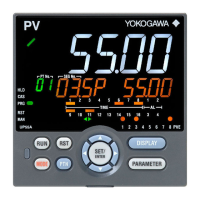1-7
IM 05P02C41-01EN
Introduction to Functions
1
1.4 ProgramPatternFunctions
The program pattern function allows performing a program operation by changing the
setpointinconjunctionwiththetimeaccordingtothepresetprogrampattern.
A program pattern consists of multiple segments.
A program pattern can be created by setting the final target setpoint, segment time, PV
event, time event, and the like.
The use of the program pattern-2 retransmission function allows creating a program
pattern for retransmission.
► Chapter 9 Program Pattern Functions
Seg. 1 Seg. 2 Seg. 3 Seg. 4 Seg. 5 Seg. 6
S.PID
TIME
S.PIDS.PID
PV event 1
S.PID S.PID S.PID
TSP
PV
TSP
TSP
TM.RT
TM.RT
The display symbols of the parameters, TSP (Final target setpoint), TIME (Segment
time setting), and S.PID (Segmet PID number selection) are the same in each
segment. However, the segment can be recognized by the number displayed on the
TSP
SSP
TSP
Ramp
Ramp
Ramp
Soak
Soak
Soak
PV high PV high
On
On
On
On On
オン
OnOff
Off Off Off
Off
Off Off Off Off OffOn
PV high PV high PV low PV low
Pattern end
TM.RT
TIME TIME
Symbol(parameter) Description
SSP (Starting target setpoint) SP at the time when the program pattern starts
TSP (Final target setopoint) Final target setpoint for the segment
TIME (Segment time setting) Determines whether to set the segment by TIME or TM.RT
TM.RT (Segment ramp-rate setting) Time to reach TSP
SEG.T (Segment setting method) Time or ramp-rate to reach TSP

